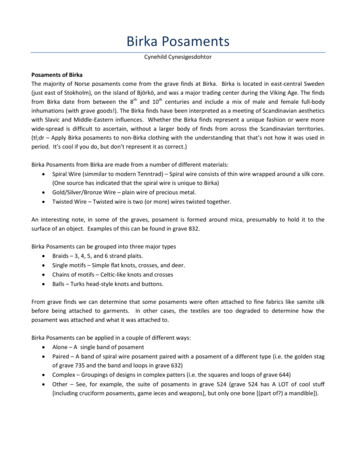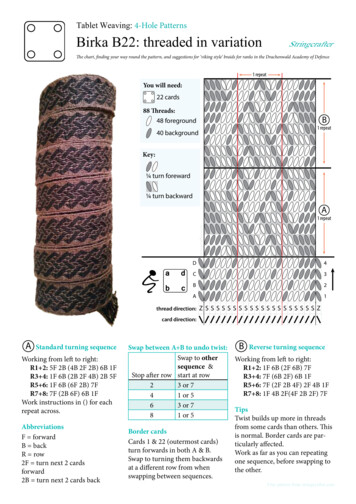
Transcription
Birka PosamentsCynehild CynesigesdohtorPosaments of BirkaThe majority of Norse posaments come from the grave finds at Birka. Birka is located in east-central Sweden(just east of Stokholm), on the island of Björkö, and was a major trading center during the Viking Age. The findsfrom Birka date from between the 8th and 10th centuries and include a mix of male and female full-bodyinhumations (with grave goods!). The Birka finds have been interpreted as a meeting of Scandinavian aestheticswith Slavic and Middle-Eastern influences. Whether the Birka finds represent a unique fashion or were morewide-spread is difficult to ascertain, without a larger body of finds from across the Scandinavian territories.(tl;dr – Apply Birka posaments to non-Birka clothing with the understanding that that’s not how it was used inperiod. It’s cool if you do, but don’t represent it as correct.)Birka Posaments from Birka are made from a number of different materials: Spiral Wire (simmilar to modern Tenntrad) – Spiral wire consists of thin wire wrapped around a silk core.(One source has indicated that the spiral wire is unique to Birka) Gold/Silver/Bronze Wire – plain wire of precious metal. Twisted Wire – Twisted wire is two (or more) wires twisted together.An interesting note, in some of the graves, posament is formed around mica, presumably to hold it to thesurface of an object. Examples of this can be found in grave 832.Birka Posaments can be grouped into three major types Braids – 3, 4, 5, and 6 strand plaits. Single motifs – Simple flat knots, crosses, and deer. Chains of motifs – Celtic-like knots and crosses Balls – Turks head-style knots and buttons.From grave finds we can determine that some posaments were often attached to fine fabrics like samite silkbefore being attached to garments. In other cases, the textiles are too degraded to determine how theposament was attached and what it was attached to.Birka Posaments can be applied in a couple of different ways: Alone – A single band of posament Paired – A band of spiral wire posament paired with a posament of a different type (i.e. the golden stagof grave 735 and the band and loops in grave 632) Complex – Groupings of designs in complex patters (i.e. the squares and loops of grave 644) Other – See, for example, the suite of posaments in grave 524 (grave 524 has A LOT of cool stuff[including cruciform posaments, game ieces and weapons], but only one bone [(part of?) a mandible]).
Unfortunately, because of the degredation of the textiles, we cannot be certain about where and to what theposament was attached. It is also difficult, because of the nature of the find, to determine if the posamentswere associated primarily women or men, or were evenly distributed between the sexes.Other Norse PosamentsViking Age Posaments have been found in Hedeby, Denmark; Huddinge, Sweden; and Gotland, Sweden (to methe items found at Gotland are not posament in the type in the Birka finds).From HuddingeFrom birkaposamente.deOther PosamentsA fifteenth century grave in Beloretschensk, Russia (near Sochi) turned up a number of posaments made ofsimple wire. The posaments were in two basic types, crosses similar to the crosses from Birka and ornamentedsquares. There is no evidence pointing to an “evolutionary” link between the posaments from Birka and theones in Russia.
The Basic KnotsFrom Birka: III. Die Textilfunde aus den Gräbern, by Agnes Geijer, pg. 100
Examples of Birka PosamentAloneBirka Grave 739 (http://mis.historiska.se/mis/sok/bild.asp?uid 349354) This posament remains attached to thesilk it was appliquéd to. The wire used in this is listed as bronze.Birka Grave 736 (http://mis.historiska.se/mis/sok/bild.asp?uid 59490)
Birka Grave 832 (http://mis.historiska.se/mis/sok/fid.asp?fid 616596&g 1)PairedBirka Grave 832(http://mis.historiska.se/mis/sok/bild.asp?uid 349622&page 1&in 1)Birka Grave 832(http://mis.historiska.se/mis/sok/bild.asp?uid 394548)
Birka Grave 735 (http://mis.historiska.se/mis/sok/bild.asp?uid 340585)ComplexBirka Grave 644 (http://mis.historiska.se/mis/sok/fid.asp?fid 617951)
Posament with MicaBirka Grave 832 (http://mis.historiska.se/mis/sok/fid.asp?fid 617954)
OtherBirka Grave 524 (http://mis.historiska.se/mis/sok/bild.asp?uid 349357 )Complete suite from Grave 524
Birka Grave 886 (http://mis.historiska.se/mis/sok/fid.asp?fid 616595&g 1)
Resourceshttp://www.eithni.com/posaments – Eithni’s KeepEithni has done some OUTSTANDING work cataloging and organizing data about the Birka posaments.She is also the source of the “how-to” pages attached to this ?sm 10 6 - The Swedish Historical Museum’s Index of BirkaGrave Goods (in Swedish with sketchy English translation)The definitive index of everything found (so far) at Birka. It’s kinda amazing.Images of the Birka finds used in this handout are from the SHM’s index, which provides their picturesunder a Creative Commons License, attribution 2.5 Sweden (CC BY 2.5 legalcode). Images used in this document werecropped to allow them to fit better on the page.https://birkaproject.wordpress.com – The Birka Project (in Swedish)http://www.silberknoten.de/en/index.php – Silberknoten (in German with English translation)Pictures and background on a handful of the Birka posaments and one from Gotland.https://timeless-textiles.com/ - Timeless TextilesA regional supplier of tenntrad, neither the most expensive or the cheapest, but the most reliableshipping.http://www.pewterofsweden.com/en/ - Pewter of SwedenA reliable Swedish source for tenntrad, they have a number of different options in terms of silvercontent and diameter.
The majority of Norse posaments come from the grave finds at Birka. Birka is located in east-central Sweden (just east of Stokholm), on the island of Björkö, and was a major trading center during the Viking Age. . Whether the Birka finds represent a unique fashion or were more wide-sprea










